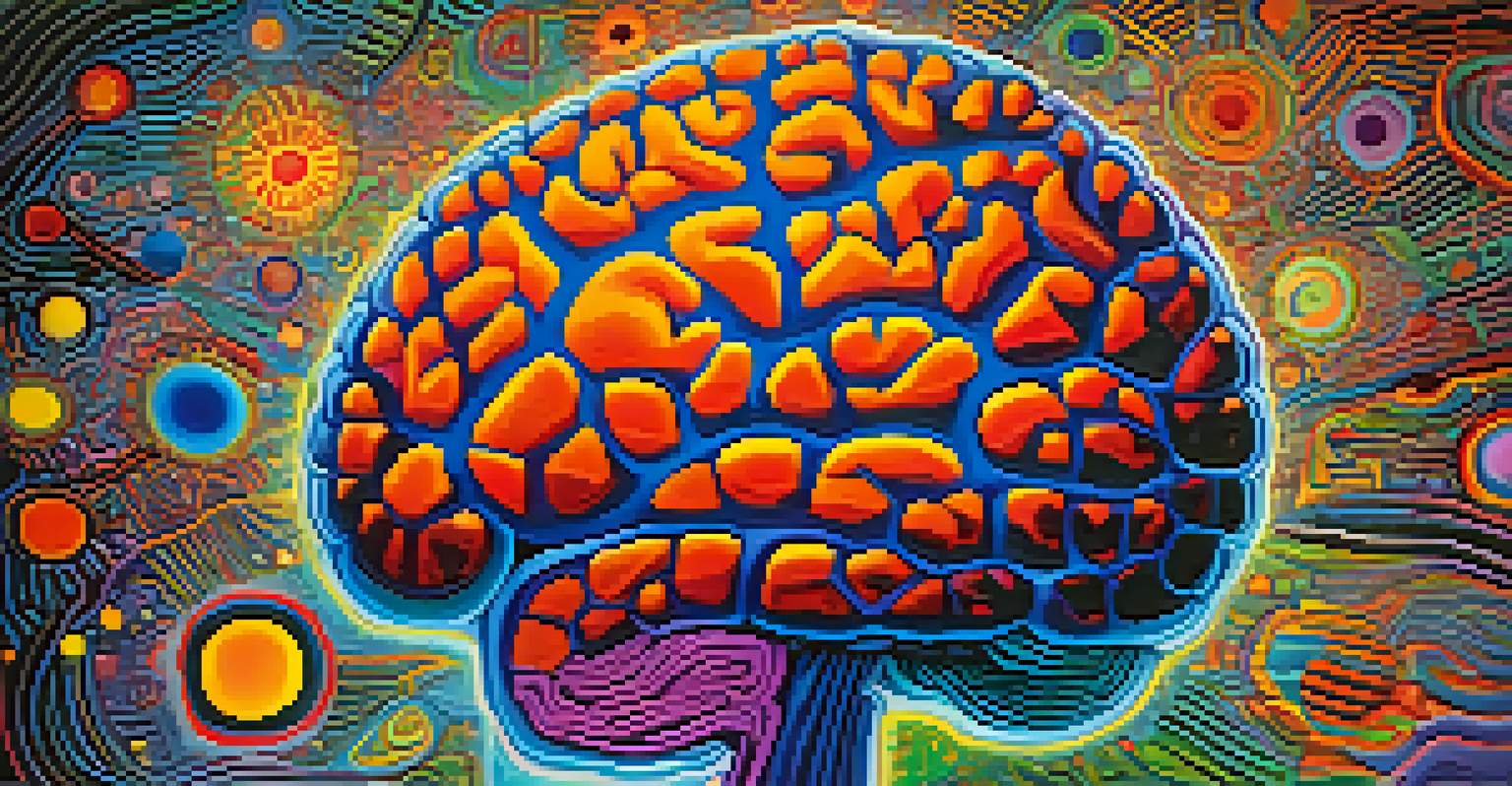Exploring the Neuroscience Behind Psychedelic-Assisted Therapy

What is Psychedelic-Assisted Therapy?
Psychedelic-assisted therapy combines traditional therapeutic practices with psychedelic substances, like psilocybin or MDMA. This innovative approach aims to treat mental health issues by fostering deep emotional insights and connections. By altering perception and consciousness, these substances may help break through psychological barriers that conventional methods struggle to address.
Psychedelics are a tool, not a panacea. They can help us to open doors, but we must be willing to walk through them ourselves.
Patients often report profound experiences during sessions, where they can confront traumas or explore feelings in ways that feel inaccessible in everyday life. The therapeutic setting, guided by trained professionals, ensures safety and support throughout this journey. It's a blend of science and subjective experience that can lead to transformative healing.
As we continue to explore this therapy, it's crucial to understand both its potential and its limitations. The intersection of neuroscience and psychedelics opens up new avenues for mental health treatment, inviting both excitement and caution in equal measure.
The Role of Neuroscience in Understanding Psychedelics
Neuroscience helps us unpack how psychedelics affect the brain by examining neural pathways and neurotransmitter systems. These substances primarily interact with serotonin receptors, particularly the 5-HT2A receptor, which plays a significant role in mood regulation and perception. This interaction can lead to altered states of consciousness, allowing for unique therapeutic experiences.

Functional MRI (fMRI) studies have demonstrated that psychedelics can increase connectivity between different brain regions. This heightened connectivity may enable individuals to access memories and emotions that are typically suppressed, promoting breakthroughs in therapy. Understanding these mechanisms is essential for harnessing the full potential of psychedelic-assisted therapy.
Psychedelics Aid Emotional Healing
Psychedelic-assisted therapy fosters emotional insights, enabling patients to confront traumas in supportive environments.
Moreover, the neuroplasticity induced by psychedelics may facilitate lasting changes in thought patterns and behavior. This means that the benefits of a single session can extend far beyond the immediate experience, offering hope for individuals with treatment-resistant conditions.
How Psychedelics Affect Emotional Processing
One of the fascinating aspects of psychedelics is their ability to enhance emotional processing. When individuals engage with these substances, they often find themselves more open to experiencing and expressing emotions. This emotional openness can lead to cathartic experiences that are essential for healing.
The mind is like a parachute. It doesn’t work if it is not open.
Research indicates that psychedelics can help reduce activity in the amygdala, the brain region associated with fear and stress responses. By diminishing fear responses, individuals may confront painful memories without being overwhelmed, allowing for a more profound therapeutic experience. This shift in emotional processing can lead to significant breakthroughs in therapy.
As patients navigate their emotions, they may also develop a greater sense of empathy and connection with themselves and others. This newfound perspective can reshape their relationships and improve overall mental well-being, emphasizing the transformative power of psychedelic-assisted therapy.
The Importance of Set and Setting in Therapy
The concept of 'set and setting' is crucial when considering psychedelic-assisted therapy. 'Set' refers to the individual's mindset going into the session, while 'setting' pertains to the physical and social environment. Both factors play a significant role in shaping the experience and outcomes of therapy.
A positive mindset can enhance the therapeutic effects of psychedelics, leading to more meaningful insights and emotional breakthroughs. Conversely, a negative mindset may lead to challenging experiences, which can hinder progress. Thus, therapists often work with patients to prepare them mentally and emotionally before sessions.
Neuroscience Unveils Psychedelic Effects
Research shows psychedelics enhance brain connectivity, promoting access to suppressed memories and lasting behavioral changes.
Creating a safe, comfortable, and supportive environment is equally important. A well-designed setting can reduce anxiety and foster trust, allowing individuals to fully engage in the experience. This careful consideration of set and setting is essential for maximizing the therapeutic potential of psychedelic-assisted therapy.
Potential Risks and Ethical Considerations
While the promise of psychedelic-assisted therapy is exciting, it is not without risks and ethical considerations. These substances can provoke intense emotional experiences, which may be overwhelming for some individuals. Careful screening and preparation are essential to ensure that patients are suitable candidates for this type of therapy.
Ethical considerations also arise regarding the accessibility and regulation of these therapies. As interest in psychedelics grows, it’s vital to ensure that treatments are delivered safely and responsibly. This includes ongoing research, training for therapists, and clear guidelines for practice.
Additionally, there is the potential for misuse of these substances outside therapeutic contexts. Ensuring that psychedelics are used responsibly and ethically is crucial for protecting vulnerable populations and maximizing their therapeutic benefits.
Current Research and Future Directions
Current research on psychedelic-assisted therapy is rapidly evolving, with numerous clinical trials underway. These studies aim to establish the efficacy and safety of various psychedelics for treating conditions like PTSD, depression, and anxiety. As the body of evidence grows, we may see a shift in how mental health treatment is approached.
Future directions in this field include exploring different substances, dosages, and therapeutic techniques. Personalized approaches that consider individual differences in response to psychedelics could enhance therapeutic outcomes. There's also increasing interest in understanding the long-term effects of these therapies.
Set and Setting Shape Therapy Outcomes
The mindset and environment of a therapy session significantly influence the effectiveness of psychedelic experiences.
As we uncover more about the neuroscience behind psychedelic-assisted therapy, it may pave the way for broader acceptance and integration into mainstream mental health care. This evolution could revolutionize the way we treat mental health disorders and offer hope to many who have struggled to find effective treatments.
Personal Stories: The Impact of Psychedelic Therapy
Hearing personal stories from those who have experienced psychedelic-assisted therapy can be incredibly powerful. Many individuals share transformative journeys where they confront deep-seated traumas and emerge with newfound clarity and emotional resilience. These narratives highlight the potential for healing that extends beyond traditional therapy.
One person might recount how a psilocybin session allowed them to process grief from a loss they had been unable to face for years. Another may share how MDMA-assisted therapy helped them rebuild trust in their relationships after trauma. These stories serve as profound reminders of the human capacity for healing and the role psychedelics can play in that process.

These personal accounts also underscore the importance of a supportive therapeutic environment. They reveal how skilled therapists can guide individuals through challenging emotions, making the experience both safe and transformative. As more people share their stories, we gain a richer understanding of the impact of psychedelic-assisted therapy on mental health.